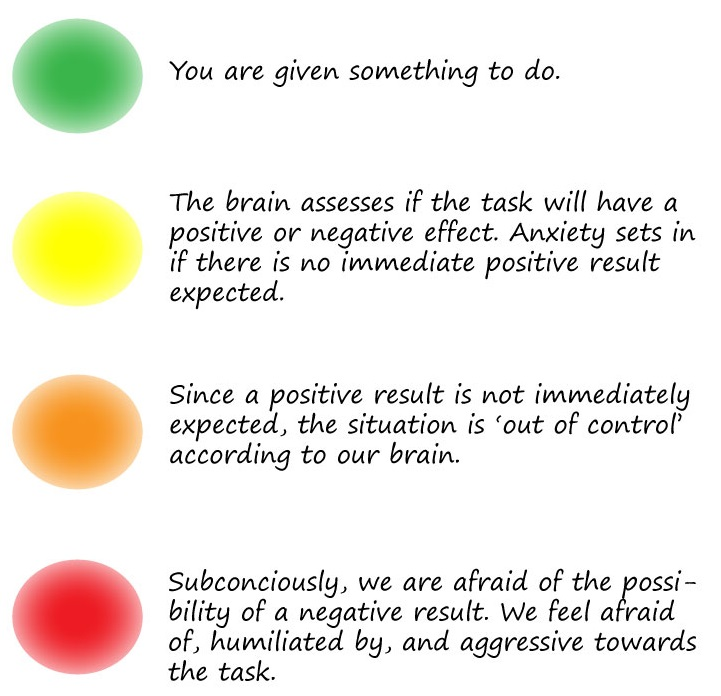The neurochemistry behind school failure or how to stop procrastinating 101
Vova Prylepa. 06/13/2021

First comes your homework, then your project, then the test and even the final exam— nothing and no one can escape the all-powerful, all-engulfing black hole of procrastination. Many people whose school performance is affected by procrastination tend to believe that they procrastinate for a variety of reasons: they believe they’re not good enough to complete or understand a specific task, they’re too lazy, or they think there’s a subconscious mechanism that maximizes their productivity under pressure. However, all of these statements are but a mere illusion— you are capable enough to finish that history project on time or to ace that biology test. Sometimes, the fact that you procrastinate isn’t even your fault, but one of the very deceptive neurotransmitters that control your impulsive decision-making: dopamine. By understanding the neurochemistry that reigns over the parts of the brain that makes us make these bad decisions, the ones that bring bitter, long-term consequences but so, so sweet short-term rewards, we can better understand procrastination, to eventually battle it and win.
As a start, we will divide our brain into many parts, but we’ll concentrate on the ones that are the most relevant to the neurochemistry of procrastination: the prefrontal system and the limbic system. The prefrontal system is the little brother of the limbic system. It is far weaker when it comes to its influence on our decision-making skills when being compared to the limbic system. The prefrontal system is responsible for the various ways in which we express our identity and our personality, for the planning of multiplex behaviors, reason and logic, while the limbic system is responsible for automatic, impulsive decisions in situations that are considered life-threatening or dangerous.
Dopamine’s role is (and has always been) to make us repeat certain behavior patterns that are likely to guarantee our survival or reproduction, dating back to the times where we ran after animals with sharp sticks. When we did a certain thing that resulted in us getting a better chance at survival or reproduction, a certain dose of dopamine would be delivered to our brain which would make us feel rewarded, relaxed and pleasured. For instance, when we eat, our brain rewards us with dopamine as consuming food is equivalent to survival. Therefore, since our brain is addicted to dopamine, it will automatically— almost unnoticeably— make us do the thing that will give us the higher dosage of dopamine, based on the predicted or experienced plausibility of an activity delivering dopamine to the brain, and thus to make us survive and reproduce.
Now, when it comes to our complex human society, this dopamine dosage technique also applies to the satisfaction of other social needs (money, status, public perception, etc) and other human needs (i.e. entertainment) rather than our primal needs. In order to make us procrastinate, our brains make the decision (mostly using our limbic system) to choose an activity that would maximize the dopamine, or the immediate reward, as opposed to the activity that has better long-term consequences, as the quantity of dopamine that’s received by the brain from the said activity is uncertain. More precisely, the limbic system contains the amygdala, which is a part of our brain that produces a powerful emotional response: a fight (resistance) or flight (ignorance) reaction to a difficult/long-term task. That effect is created by the production of norepinephrine (causing fear and anxiety) and even adrenaline, similarly to a reaction produced to a life-threatening situation except that now, the only thing threatened is your comfort zone.
The amygdala plays a more important part in our rationale, as it takes 1/32 of a second to send its chemical signal, as opposed to the three seconds take by the prefrontal system to generate a well-evaluated, rational thought. The amygdala is simply faster, so we listen to it more when making a decision. Essentially, this reaction with norepinephrine is simply a way for our brain to avoid a task low in immediate dopamine to take part in an activity that guarantees a dopamine release in the shortest delays. This explains the fact that you are more drawn to play Angry Birds than to do your chemistry homework— although your prefrontal system knows that in the long run, the chemistry homework will benefit you more and might bring you dopamine (pleasure) if you do it right, the limbic system, the more dominant one, will make you strive for the more immediate and certain reward, the one that requires less effort and time to get that desired dopamine dosage. That dreaded homework, on the other hand, will get postponed to a later date, and then an even later one until it sinks into oblivion.
To combat this, we need to rewire our brains into thinking of long-term tasks as the ones that bring the most dopamine (pleasure), and not the most norepinephrine/adrenaline (fight-flight response) for the victory in the fight against procrastination. Here are a few mental techniques that would allow you to do that:
1: Create an environment that’s conducive to focus and work. By eliminating all kinds of distractions around you, such as putting your phone away, cleaning your work desk from useless items and closing all kinds of unimportant tabs on your computer, you take away all kinds of short-term sources of dopamine, leaving only long-term sources of dopamine (like working on a project or studying for a test) to your brain. This way, by leaving it no choice, your brain is obliged to choose the only potential source of dopamine available, even though the amygdala is telling it that the levels of dopamine brought by this activity are uncertain.
2: Set small goals and divide a big assignment into a series of smaller ones and set up a reward structure. The brain cannot tolerate any activities that don’t bring dopamine any soon, the amygdala making our focus shift to more rewarding activities. However, if we divide a task into smaller parts, which we do during set periods of time and get rewarded after that certain period of time, the amygdala considers each small part of that big task as a short-term source of dopamine. Thus our limbic and prefrontal cortex work in conjunction to guarantee the completion of the said long-term task, bit by bit. One method to use is the Pomodoro method, where one has to work for 25 minutes and take a short break after each work period, rewarding him or herself with a snack, a walk or simply a series of stretching exercises.
3: Don’t be afraid to start and ask questions. People often procrastinate because they are too intimidated by a specific task or are too afraid to ask their teachers, supervisor, colleagues or friends about something they don’t understand, so they just never start. Just blindly starting a task without overthinking it would allow you to procrastinate far less. In fact, if you don’t know how to approach a specific activity, you can use the five minutes rule: you’ll have to invest yourself into something for only five minutes, but you’ll have to do it thoroughly. It would allow your cognitive muscles to warm up and after five minutes, you’ll lose your fear of the task and keep doing it almost automatically.
In the end, don’t forget that when you procrastinate, you exchange potential big future rewards for smaller, futile pleasures. Some things just can’t be done tomorrow, and the best time to start them is today and now. Don’t be your dopamine’s slave— you can seek help for procrastination issues and no one will judge you for it. It is by disciplining your brain that you will be able to reach anything you want in life.
Cover Photo: (Tiny Buddha)
